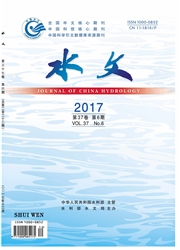

 中文摘要:
中文摘要:
探索地下水系统演化的过程与机制对流域水资源的可持续管理至关重要。基于地下水多年动态观测资料和地统计学方法,按不同灌溉方式分区估算了张掖盆地1985~2013年地下水资源变化情况。结果表明:整个张掖盆地地下水水位降深和储量在时空上表现出很大差异性,基本经历了三个阶段:1985~1997年匀速下降阶段,1998~2004年加速下降阶段和2005~2013年减速下降阶段。整个盆地累积储量减少了47.52×108m^3,年均亏缺1.64×108m^3,其中河水井水灌区累积地下水位降深达5.72m,储量减少了37.48×108m^3,占地下水消耗量的78.87%。各分区累积水位降深变化从高到低依次为:河水﹥河水井水﹥泉水﹥河水泉水≥井水灌区,相应的累积储量变化依次为:河水井水﹥河水﹥井水﹥河水泉水﹥泉水灌区。从长时间尺度看,各分区及张掖盆地多年累积储量仍为负变化,即地下水资源仍处于较严重亏缺状态,对含水层造成很大威胁。这是气候变化与人类活动共同作用的结果,而人类活动如分水政策、引水灌溉、地下水开采等影响越来越强烈。结果可以为黑河流域水量均衡合理估算、地下水数值模拟和水资源统一规划调度提供科学依据。
 英文摘要:
英文摘要:
Understanding the behavior of the groundwater body and its long term trends is essential for making any management decision in a given watershed. This paper made an estimation of the groundwater resources variation in the Zhangye Basin during 1985-2013 based on the long-term groundwater observation data and geostatistical method by partitions according to the different ways of irrigation. The results show that groundwater level and storage exhibit tremendous dissimilarity on temporal and spatial scale for the whole Zhangye Basin. The accumulative groundwater storage decreased by nearly 47.52 ×108m^3, the annual average deficit reached 1.64 ×108m^3, among which the accumulative groundwater level drawdown in the river/well water mixed irrigation district reached 5.72 m, groundwater storage decreased by 37.48 ×108m^3,accounting for about 78.87% of the total water loss of the Zhangye Basin. Accumulative groundwater level drawdown changed from high to low order in respective partitions: river water ﹥ river and well water mixed ﹥ spring water ﹥ river and spring water mixed ≥ well water irrigation district, and the corresponding accumulative storage variation is: river and well water mixed ﹥ river water ﹥ well water ﹥ river and spring water mixed ﹥ well water irrigation district. In the long-temporal scale, multi-year accumulative storage in these partitions is still in negative change,namely the groundwater resource is still in a rather severe deficit, which would make a great threat to the aquifer. This is the result from the joint action of climate change and human activities, and human activities such as water diversion policy, groundwater mining and water saving project have become greater and greater. This study may provide a scientific basis for water resources planning and scheduling and provide relatively reliable way of estimating large scale groundwater balance.
 同期刊论文项目
同期刊论文项目
 同项目期刊论文
同项目期刊论文
 期刊信息
期刊信息
